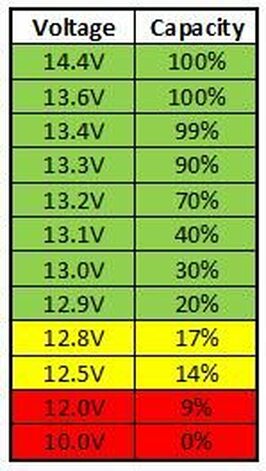Hello everyone,
I'm curious about these voltages 13.6-14.4. My charges is set to 14.4 to charge bulk/absorb and 13.6 float.
I have hooked up 3 batteries in parallel, before connecting them I charged all of them to 14.4, and left them to rest 1-2 days. These were their voltages before connecting them - 13.25, 13.25 13.49. Is the 13.49 a little too off?
Anyway when I connected them they gave a 13.33 avarage which I think is ok. I charged it to 14.4.
What I see is when I leave the float to drop to 13.6 while the charger is connected and floating, it drops much faster to 13.6 from 14.4 then If I charge it to 14.4 and right when the charger goes to float turn off the charger. After the charger is off and have not waited for the charger to bring it down to 13.6, I see that the voltage drops much slower when not waiting for the float to drop it, is this normal? Actually I'm not sure if it will ever drop to 13.6, if not left on the float setting to make it drop, correct?
Is anywhere from 13.6-14.4 voltage concidered fully charged? And I should not worry that the battery bank is not at 13.6, instead at 14.07 like at the moment?
Thanks.
I'm curious about these voltages 13.6-14.4. My charges is set to 14.4 to charge bulk/absorb and 13.6 float.
I have hooked up 3 batteries in parallel, before connecting them I charged all of them to 14.4, and left them to rest 1-2 days. These were their voltages before connecting them - 13.25, 13.25 13.49. Is the 13.49 a little too off?
Anyway when I connected them they gave a 13.33 avarage which I think is ok. I charged it to 14.4.
What I see is when I leave the float to drop to 13.6 while the charger is connected and floating, it drops much faster to 13.6 from 14.4 then If I charge it to 14.4 and right when the charger goes to float turn off the charger. After the charger is off and have not waited for the charger to bring it down to 13.6, I see that the voltage drops much slower when not waiting for the float to drop it, is this normal? Actually I'm not sure if it will ever drop to 13.6, if not left on the float setting to make it drop, correct?
Is anywhere from 13.6-14.4 voltage concidered fully charged? And I should not worry that the battery bank is not at 13.6, instead at 14.07 like at the moment?
Thanks.
Last edited:




